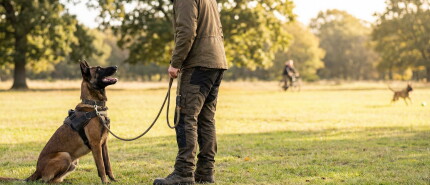Why don’t you use a harness during tracking?
This is a question that comes back during every seminar. Many people use a harness during tracking with their dog. It is of course everybody’s own choice to use a harness or collar. But over the years it has become very clear to me which is the best thing to do. We always use the collar while tracking.
During a seminar in Canada I had the opportunity to show the advantage of the collar over a harness. All participants in the seminar normally used a harness while tracking. As with many other handlers in the past, I saw the same pattern recurring here when tracking on a harness. The dog sniffs the ground and once it finds the track, it runs in that direction and starts pulling. The handler then follows his dog at a high pace, often running. As soon as there is a corner and the dog has lost the track, the dog will start circling around his handler. This until he has found the track again.

Of course, this is also a system that works. I have also seen good dogs tracking in this system. And probably many criminals have been arrested worldwide by using this system. But to be honest, I don’t think this is the best system to get the best results. I will explain why I think so.
A harness does not hinder the dog while pulling.
A harness gives the dog the opportunity to pull. But also to pull hard, without bothering the dog. This is due to the construction of the harness. When training rescue dogs, we always used harnesses to lift the dogs without bothering them. But in tracking, the disadvantage of this is that the dog can also pull without problems when he has lost the track. This makes him use up a lot of energy unnecessarily. He can and will concentrate much harder to find the track again.
The harness can therefore be used much more difficult during the training of a dog for tracking to regulate the speed or, if necessary, to correct. If there are tracks that are easy for the dog to smell, then this system can be used. But if the track is more difficult, then a dog running around on a harness will have much less success in finding the track again. So the use of a harness usually goes hand in hand with the system used during tracking.
We always use a collar.
Therefore, when training our dogs, we always use a collar. This allows us to better exercise and regulate the speed of the dog. Or to correct the dog if necessary.
In our system, two things are very important:
- When the dog is following the track, then he is allowed to pull. If the dog pulls very hard, we can regulate the speed more easily with the collar.
- If the dog has lost the track, we train our dogs not to pull.

Training in this system has a great advantage. When the dog is on the track he gets all the freedom to do his job. But if he loses the track, the dog will slow down of his own accord and search very accurately and concentrated to find the track again. This is very important when it becomes more difficult for a dog. For example, for top-level training on paved surfaces in a mall.
The other day in our Online Training School we showed a track with a 10 month old dog. The grass on this field had been cut that morning and children had been playing on the field all day. The dog, trained in our system, did his job well and followed the trail. Sometimes with more speed, but when things got difficult, the dog would slow down on his own and work out the track very precisely. A good example of training according to our system.
A harness can be a context.
Of course, you can use a harness to give the dog a clear context of what to do. In the past, I have used a harness to give my dogs clarity: We’re going to do tracking now, and no bite work. Then we’d go tracking and I’d put the leash on the collar.
And yes, if you are short behind a criminal and you want to catch him, you can also speed up more while tracking with the collar and run after your dog if necessary.






